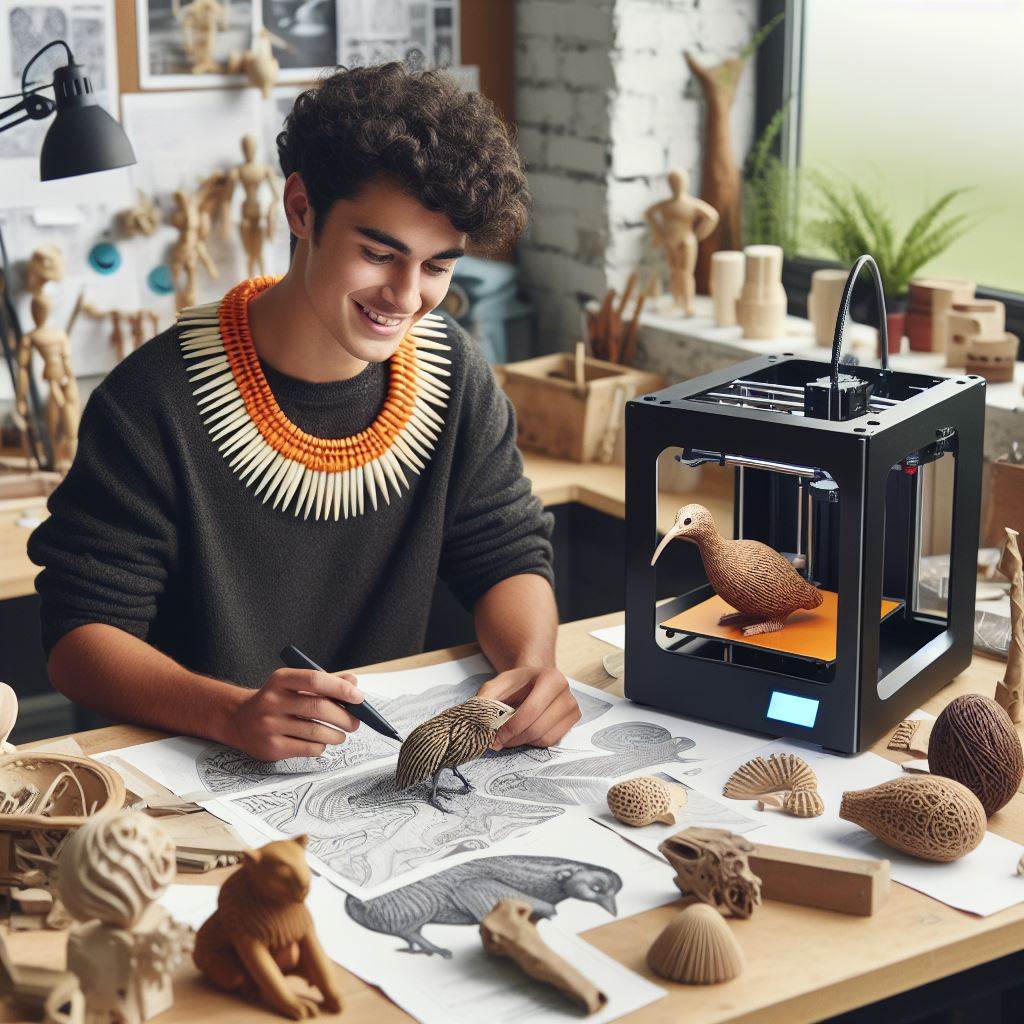Introduction
3D printing is a revolutionary manufacturing process that builds three-dimensional objects layer by layer.
It has transformed industries by enabling rapid prototyping, customized production, and cost-effectiveness.
Its significance in modern industries cannot be overstated.
From aerospace to healthcare, 3D printing offers unparalleled versatility and innovation, allowing businesses to create intricate designs and prototypes with ease.
Drafting plays a crucial role in the 3D printing process.
Drafters use specialized software to design detailed digital models that serve as blueprints for 3D printers.
These models must be precise and accurate to ensure the final product meets the desired specifications.
Moreover, drafters need to consider various factors such as material compatibility, structural integrity, and manufacturing feasibility when creating 3D printable designs.
In essence, drafting and 3D printing are deeply intertwined, with drafting providing the foundation for successful 3D printing outcomes.
As the demand for 3D printed products continues to grow across industries, the importance of skilled drafters proficient in 3D modeling and design will only increase.
Therefore, understanding the connection between drafting and 3D printing is essential for aspiring drafters and professionals alike, as it opens up numerous opportunities for innovation and advancement in the rapidly evolving landscape of modern manufacturing.
3D Printing in New Zealand
Growth and adoption of 3D printing technology in NZ
- New Zealand has witnessed significant growth in the adoption of 3D printing technology.
- Many individuals and businesses are recognizing the potential of this innovative technology.
- The availability of advanced 3D printing machines and materials has fueled its widespread adoption.
- Local universities and research institutions are actively exploring the potential applications of 3D printing.
- The government has also recognized the importance of this technology and supports its development.
- As a result, 3D printing is revolutionizing various sectors across New Zealand.
Key industries utilizing 3D printing in the country
- The manufacturing industry in New Zealand is actively integrating 3D printing into its processes.
- Architects and construction firms are using 3D printing for creating accurate and detailed models.
- The healthcare industry is leveraging 3D printing to produce customized medical devices and prosthetics.
- Jewelry and fashion designers are embracing 3D printing for its capabilities in creating intricate designs.
- Education and research institutions are incorporating 3D printing into their curricula and experiments.
- The automotive and aerospace industries are utilizing 3D printing for rapid prototyping and parts manufacturing.
Examples of successful 3D printing projects in NZ
- In the medical field, a team at the University of Auckland successfully 3D printed a functional human liver.
- Weta Workshop, a renowned special effects company, used 3D printing to create intricate props for movies.
- A local fashion designer utilized 3D printing to develop unique and customizable pieces for a fashion show.
- Fonterra, a New Zealand dairy company, utilized 3D printing to create customized molds for cheese production.
- A construction company in Christchurch employed 3D printing to create disaster-resistant building components.
- A leading automotive manufacturer used 3D printing to produce high-performance car parts with complex geometries.
Overall, 3D printing has gained traction in New Zealand with its growth in adoption across various industries.
The country’s supportive environment, coupled with advancements in technology, has paved the way for successful projects and innovative applications.
As 3D printing continues to evolve, its impact on the New Zealand scene is expected to expand even further.
Read: Essential Skills for NZ’s Electrical Engineers
3D Printing Education and Training
Availability of educational programs focused on 3D printing in NZ
- The rapid growth of 3D printing technology has fueled the demand for educational programs in New Zealand.
- Several institutions across the country now offer specialized courses and programs that focus on 3D printing.
- Students who are interested in pursuing a career in this field have a variety of options to choose from.
- These educational programs are designed to provide students with the necessary knowledge and skills to excel in 3D printing.
- The availability of these programs reflects the growing importance and relevance of 3D printing in various industries.
Major universities and institutions offering courses and degrees in 3D printing
- The University of Auckland is one of the major institutions offering a course in 3D printing.
- This course covers various aspects of 3D printing, including design, manufacturing, and applications.
- The University of Canterbury also offers a bachelor’s degree program in Mechanical Engineering with a focus on 3D printing.
- Other institutions, such as Otago Polytechnic and AUT University, provide specialized courses and workshops in 3D printing.
- These universities and institutions are committed to providing high-quality education and training to meet the industry’s demands.
Importance of skill development in 3D printing for future career prospects
- With the increasing adoption of 3D printing across industries, the demand for skilled professionals is on the rise.
- Having expertise in 3D printing can significantly enhance career prospects and open up new opportunities.
- Employers value individuals who possess the ability to leverage this technology for innovative and efficient problem-solving.
- Skill development in 3D printing can lead to exciting job roles such as 3D printing engineer, designer, or technician.
- Furthermore, individuals with expertise in 3D printing can contribute to research and development in this rapidly evolving field.
- Continuous learning and staying updated with the latest advancements in 3D printing is essential for career growth.
- Therefore, investing in educational programs and training opportunities can be highly beneficial for individuals aspiring to enter the 3D printing industry.
In review, the availability of educational programs and training opportunities focused on 3D printing in New Zealand reflects the growing demand for skilled professionals in this field.
Major universities and institutions, such as the University of Auckland and the University of Canterbury, offer courses and degrees that enable students to acquire the necessary knowledge and skills.
Skill development in 3D printing is crucial for future career prospects, as it opens up a wide range of job opportunities and allows individuals to contribute to the advancement of this technology.
By investing in education and training, aspiring professionals can navigate the evolving landscape of 3D printing with confidence and competence.
Read: Interview: NZ Electrical Engineers’ Success Stories
Innovative Applications of 3D Printing in NZ
Healthcare sector: 3D printed prosthetics and medical devices
In the realm of healthcare, 3D printing has revolutionized the production of prosthetics and medical devices.
New Zealand has embraced this technology, leading to innovative applications that significantly impact patients’ lives.
Through 3D printing, customized prosthetics can be created, perfectly fitted to an individual’s unique anatomy.
This personalization greatly enhances comfort and functionality, improving patients’ quality of life.
Moreover, 3D printed medical devices such as implants and surgical tools have proven to be reliable and cost-effective.
The ability to produce complex shapes and intricate designs through this technology has opened up new possibilities in the healthcare sector.
Architecture and construction: 3D printed building components
In the architecture and construction industries, 3D printing is making waves by enabling the production of building components.
New Zealand architects and designers are utilizing this technology to create intricate structures that were once unimaginable.
By 3D printing building components, construction projects become more efficient, cost-effective, and sustainable.
The ability to fabricate complex geometries and unique designs allows for unprecedented freedom and creativity in architectural expression.
Additionally, 3D printing minimizes waste generated during construction and reduces the need for labor-intensive manufacturing processes.
Aerospace and automotive industries: 3D printed parts and prototypes
The aerospace and automotive industries in New Zealand are also leveraging the power of 3D printing.
By utilizing this technology, manufacturers can produce lightweight and high-performance parts and prototypes.
3D printing enables the creation of intricate designs with complex internal structures, resulting in improved functionality and reduced weight.
Moreover, the ability to rapidly prototype and iterate designs using 3D printing accelerates the product development process.
This technology has transformed the way aerospace and automotive companies approach manufacturing, leading to more innovative and efficient solutions.
Art and design: Creative use of 3D printing technology
The art and design community in New Zealand has fully embraced 3D printing as a medium for creative expression.
Artists and designers are pushing the boundaries of what is possible with this technology, exploring its capabilities to produce unique and intricate artworks.
From sculptures to jewelry, 3D printing allows artists to translate their imagination into tangible objects with exceptional detail and complexity.
The ability to experiment with various materials and textures further expands the creative possibilities.
This integration of art and 3D printing technology has opened up new avenues for artistic exploration and innovation in New Zealand.
In essence, 3D printing is making significant strides in various sectors in New Zealand.
From the healthcare sector to architecture, aerospace, and art, this technology is transforming industries and providing innovative solutions.
The ability to customize and personalize products, shorten production timelines, and reduce costs has revolutionized manufacturing processes.
New Zealand continues to foster the growth and development of 3D printing, positioning itself as a leader in leveraging this cutting-edge technology.
Read: Women in Electrical Engineering in NZ

Future Outlook and Challenges
Potential advancements and future trends in 3D printing
- Increased adoption of 3D printing in various industries such as healthcare, automotive, and aerospace.
- Development of advanced materials, allowing for the creation of complex and functional objects.
- Integration of 3D printing with other emerging technologies like artificial intelligence and robotics.
- Expansion of the consumer market, with more affordable and user-friendly 3D printers becoming available.
- Customization becoming a key driver, enabling individuals to create personalized products.
The future of 3D printing in New Zealand looks promising, with several potential advancements and trends expected to shape the industry.
As the technology continues to mature, it is likely to see increased adoption across various sectors.
Industries such as healthcare, automotive, and aerospace are already exploring the possibilities offered by 3D printing.
The ability to create complex and functional objects using advanced materials opens up endless opportunities for innovation.
The integration of 3D printing with other emerging technologies like artificial intelligence and robotics further enhances its capabilities.
This convergence allows for the automation of the entire manufacturing process, from design to production, leading to increased efficiency and reduced costs.
As a result, the consumer market is expected to grow, with more affordable and user-friendly 3D printers becoming accessible to a wider audience.
Challenges faced by the 3D printing industry in NZ
- Limited access to funding and investment capital, hindering research and development efforts.
- Lack of skilled workforce with expertise in 3D printing technology and design.
- Intellectual property concerns due to the ease of replicating and sharing digital designs.
- High costs associated with the acquisition of 3D printing equipment and materials.
- Limited awareness and understanding about the potential applications and benefits of 3D printing.
However, the 3D printing industry in New Zealand also faces several challenges that need to be addressed for sustained growth.
Access to funding and investment capital is crucial for research and development efforts to flourish.
Without adequate financial support, it becomes challenging for innovators and startups to experiment and refine their ideas.
Government support through funding programs and collaborative research projects can help overcome this obstacle.
Another challenge is the shortage of skilled professionals with expertise in 3D printing technology and design.
To foster innovation, there is a need to develop educational programs and training initiatives that equip individuals with the necessary skills.
By investing in the development of a skilled workforce, New Zealand can establish itself as a hub for 3D printing innovation.
Intellectual property concerns also arise with the ease of replicating and sharing digital designs in the 3D printing realm.
To protect innovation while encouraging collaboration, policies and regulations need to be established that safeguard intellectual property rights.
This balance will provide a conducive environment for creativity and innovation to thrive.
Government initiatives and support for fostering 3D printing innovation
- Establishment of collaborative research projects between industry and academic institutions.
- Development of funding programs that specifically target 3D printing startups and research initiatives.
- Creation of educational programs and training opportunities to address the skills gap in 3D printing.
- Formation of strategic partnerships with international organizations to leverage global expertise.
- Implementation of policies and regulations to protect intellectual property while encouraging innovation.
The New Zealand government recognizes the potential of 3D printing and has taken steps to support its growth.
Initiatives such as funding programs specifically targeting 3D printing startups and research projects have been implemented.
Collaborative efforts between industry and academic institutions are being encouraged to foster innovation through knowledge exchange.
Additionally, strategic partnerships with international organizations are being formed to leverage global expertise and stay at the forefront of technological advancements.
Most importantly, the future of 3D printing in New Zealand holds great promise.
The potential advancements in 3D printing technology, coupled with government initiatives and support, create a conducive environment for innovation.
However, challenges such as funding accessibility, skills gap, and intellectual property protection must be addressed to ensure the sustainable growth of the 3D printing industry in New Zealand.
With the right strategies and investments, New Zealand can position itself as a leader in 3D printing innovation.
Read: The Future of Electrical Engineering in NZ
Conclusion
Recap of the significance of 3D printing in the NZ scene
Personalized Career Consulting
Unlock your potential with expert career advice tailored to your goals. Get personalized guidance and actionable steps toward your dream career in New Zealand.
Get StartedEncouragement for readers to explore the possibilities of 3D printing in their careers
Final thoughts on the impact and potential of 3D printing in New Zealand
In closing, the significance of 3D printing in the New Zealand scene cannot be overstated.
It has revolutionized various industries, such as architecture, manufacturing, and healthcare.
3D printing offers endless possibilities for individuals to explore and tap into their creativity.
Whether you are an aspiring designer or an engineer, integrating 3D printing into your career can expand your horizons and open new doors.
The impact of 3D printing on the New Zealand economy and innovation landscape is immense.
As the technology continues to evolve, we can expect more groundbreaking advancements and discoveries in various fields.
It is crucial for individuals and businesses in New Zealand to stay up-to-date with the latest developments in 3D printing and leverage its potential.
Embracing this technology can drive economic growth, encourage innovation, and foster a culture of creativity within the country.
In the end, 3D printing has already proven to be a game-changer in New Zealand and will undoubtedly continue to shape the future of various industries.
It is an exciting time to witness and be part of this transformative technology.




